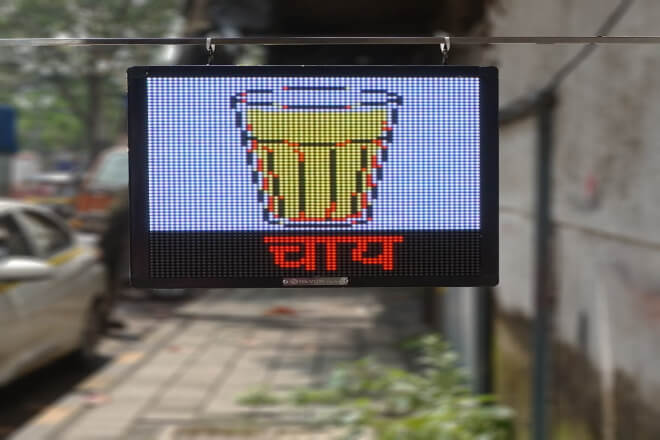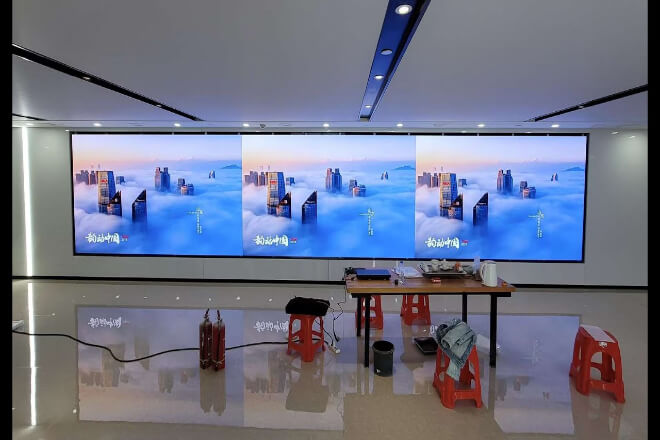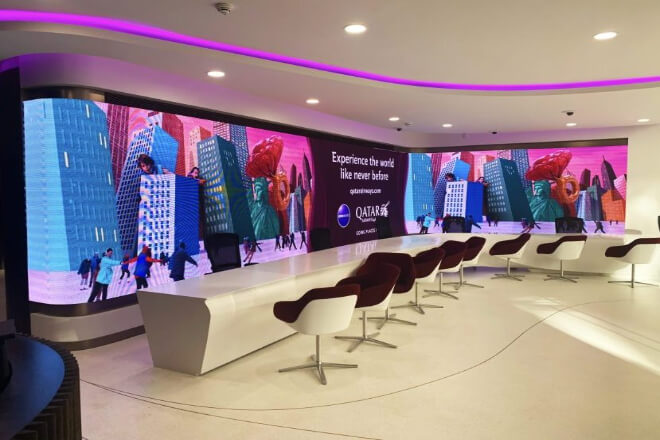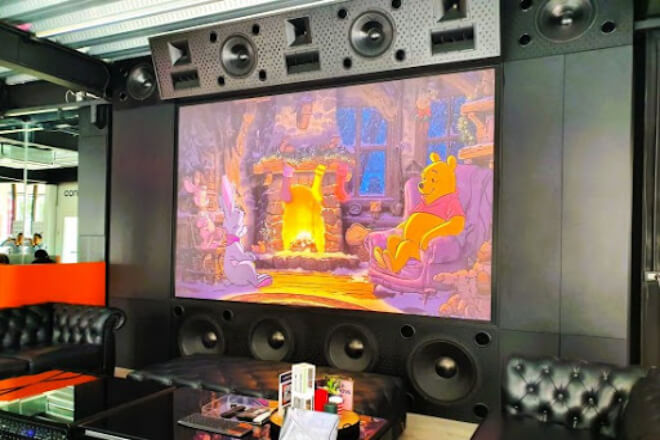Introduction
Can the tea room also become a secret weapon for brand communication? A low-key and exquisite LED screen may be the key you have overlooked. How to quietly convey the brand temperature and texture when employees relax?
Table of Contents
Method 1: Use LED screens in a low-key manner

LED display screens are often linked to “eye-catching”, but in the space of the tea room, if the screen still pursues coolness and high brightness, it is easy to destroy the original relaxed atmosphere.
The tea room is a place for employees to relax and escape from the office rhythm for a short time. The role of the screen here is not the “protagonist”, but the “foil”.
Therefore, the use of LED screens should be as “low-key” as possible-not too bright, not overshadowing, but can just convey the brand’s texture.
This low-key does not mean no sense of existence, but allows the screen to naturally blend into the environment, allowing people to inadvertently feel its intentions.
For example, the brightness of the screen should be soft to avoid being dazzling in natural light or warm light environment.
Try to choose low-saturation brand auxiliary colours, such as grey-blue, light ink green, and beige, which are neither jumpy nor can they continue the style of the space.
The size does not need to be large. Long strip screens and small square screens are embedded in the corners of the tea cabinet, bookshelf, and beverage area, which makes it easier to create a “just right” visual experience.
In terms of content, it is recommended to display some static or slowly transitioning information, such as brand quotes, holiday greetings, employee activity photos, tea culture knowledge, etc.
The rhythm is quiet and does not disturb people, which just gives the brand a low-key but real opportunity.
In short, the key to using LED screens in the tea room is not to “be seen”, but to “be felt”.
A truly low-key design is the kind that you will not notice immediately, but always feel that it makes the space more textured and more humane.
Method 2: Choose the right location and size for the LED display

After all, the tea room is a place for employees to relax, drink water and chat. If the LED screen is placed in the wrong place or is too large.
It will make people feel abrupt and destroy the original relaxed atmosphere. Therefore, the position and size of the screen must be carefully considered.
The key to a reasonable layout is to make the LED screen blend into the environment naturally, as if it is “hidden”.
In addition to the conventional wall, we can also place the screen above the tea cabinet, next to the storage rack, or even embed it into the groove of the wall.
This looks more harmonious and will not make the screen too “eye-catching”. Such a design will make employees feel that the screen is part of the space, not an abrupt “display”.
Speaking of size, it is actually unnecessary to use a large screen in the tea room. A narrow strip of a small screen or a small square screen is more suitable, which can display the necessary information.
For example, brand quotes, holiday greetings, and tea culture tips will not steal the limelight from the tea room.
With a small size, the screen looks more like a decoration rather than a billboard, and the atmosphere is warmer.
The hidden design is also very practical. For example, wrap the screen frame with a material similar to the wall or furniture, or embed the screen into the bookshelf or wall.
So that the screen is like a “little secret” hidden in the corner, which is easy to use and not abrupt.
In addition, the actual use experience should be considered when choosing the location and size.
A screen that is too large may make people feel depressed, and there will be reflections if the location is not appropriate. It may be difficult to see if it is too small.
Only by finding the “just right” size and position can the LED screen convey the brand culture without disturbing everyone’s rest and relaxation.
In the final analysis, choosing the right location and size is the first step to make the LED screen play a role in the tea room.
It is not used to “show off”, but to quietly add some ingredients to the space, convey the brand’s temperature, and make people feel that this is a place created with care, not a simple workshop.
Method 3: Optimise the content presentation of the LED screen

The content design of the LED screen is actually more important than the screen itself. In a place like the tea room that pays attention to comfort and atmosphere.
If the content is too fancy and too messy, it will make people feel uncomfortable and even affect the overall experience.
Therefore, only by presenting the content well can the LED screen really play the role of adding points to the brand.
First of all, we should pay attention to the “refinedness” of the visual content. This does not only mean that the picture is clear, but also that the arrangement of the elements of the picture.
The choice of fonts, and the blank space of the picture should be delicate and have a sense of quality.
For example, using a simple format to display a warm brand quote, coupled with a background suitable for the brand’s tone, even if it is just a static picture, can give people a very comfortable visual experience.
Secondly, the colour tone and style should be unified. The colour of the LED screen should preferably be consistent with the overall design of the tea room.
Or echo the brand’s VI colour tone. Avoid jumping colours and styles, such as using bright red and bright yellow on the screen, while the tea room is warm wood colour and soft lighting.
This contrast will make people feel out of place. The unified style makes people look pleasing to the eye, and it is easier for the brand image to take root in the hearts of employees.
Another key point is the balance between “dynamic effects and static display”. A completely static picture may appear a bit monotonous, but the frequent and fast switching animations can easy to distract people.
The best approach is to use slight dynamic effects, such as a slowly changing, gently moving background, with concise and clear text and pictures.
Such dynamics will not be eye-catching, but can also make the screen “alive”, giving people a comfortable sense of rhythm.
In short, optimising content presentation is to make the LED screen a “gentle storyteller” in the tea room, quietly conveying the brand’s story and culture to every employee.
Carefully designed content can touch people’s hearts more than simple technical displays, and also make this small screen truly the soul of the space.
Method 4: Integration of display content and brand elements

The LED screen in the tea room is not only a tool for displaying information, but also a carrier for conveying brand culture.
To achieve this, the content on the screen must be deeply integrated with the company’s brand elements.
So that employees can feel the unique temperament and value of the brand during their daily rest.
First of all, the content should be customised and closely linked to the brand colour. For example.
The screen background colour, text colour and animation elements should try to use the brand’s main and auxiliary colours.
In this way, the content on the screen and the brand image in the space are naturally integrated, and people will not feel separated.
Customised design can also reflect the company’s sense of exclusivity, making employees feel that this is “our” screen, not just any display device.
Secondly, the company’s iconic elements should be cleverly integrated. LOGO, brand mascot, core graphic symbols, or classic patterns representing company culture can all be used flexibly in the content.
They can be used as background decorations or appear in the corners of each content, so that the brand image can be “subtly” conveyed to everyone.
Of course, the expression of text, images and brand stories is also critical. Simply listing product information or rules and regulations can easily make the content look dry.
On the contrary, if you use warm language to tell the brand’s original intention, team stories, and employee style.
And then match them with vivid pictures or illustrations, you can bring the brand culture vividly into the employees’ sight and enhance their sense of identity and belonging.
In general, the integration of content and brand elements is not only a unified design, but also an emotional connection.
Only in this way can the LED screen content truly make the tea room a “small theatre” of brand culture, allowing employees to feel the warmth and spirit of the company unconsciously.
5. Conclusion
Brand awareness does not necessarily need to be loud and fanciful. Sometimes, the more low-key it is, the more it can impress people. Can your tea room also become a gentle narrator of brand stories?
Why not start with a small LED screen, so that employees can feel the company’s care and warmth every time they pour water.
Finally, if you want to know more about LED display screens, please get in touch with us.
